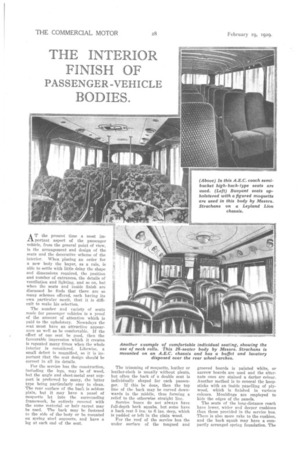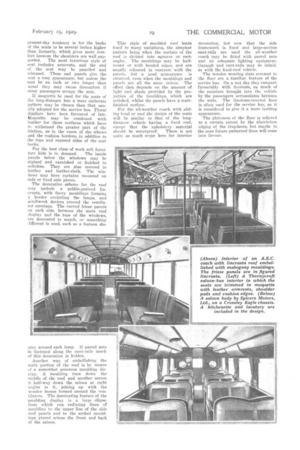THE INTERIOR
Page 118

Page 119

If you've noticed an error in this article please click here to report it so we can fix it.
FINISH OF
PASSENGER -VEHICLE
BODIES.
ATthe present time a most important aspect of the passenger vehicle, from the general point of view, is the arrangement and design of the seats and the decorative scheme of the interior. When placing an order for a new body the buyer, as a rule, is able to settle with little delay the shape and dimensions required, the position and number of entrances, the details of ventilation and lighting, and so on, but when the seats and inside finish are discussed he finds that there are so many schemes offered, each having its own particular merit, that it is difficult to make his selection.
The number and variety of seats made for passenger vehicles is a proof of the amount of attention which is paid to the upholstery. Nowadays the seat must have an attractive appeartwee as well as be comfortable. If the effect of one seat be good, then the favourable impression which it creates is repeated many times when the whole interior is considered. Likewise, a small defect is magnified, so it is important that the seat design should be correct in all its details_ For the service bus the construction, including the legs, may be of wood. but the angle and sheet-metal seat support is preferred by many, the latter type being particularly easy to clean. The rear surface of the bac:s is seldom plain, but it may have a panel of moquette let into the surrounding framework, be entirely covered with the same material or hair carpet may be used_ The back may be fastened to the side of the body or be mounted on spring steel supports, and have a leg at each end of the seat. The trimming of moquette, leather or leather-cloth is usually without pleats, but often the back of a double seat is individually shaped for each passenger. If this be done, then the top line of the back may be curved downwards in the middle, thus forming a relief to the otherwise straight line.
Service buses do not always have full-depth back squabs, but some have a back rest 5 ins: to 6 ins, deep, which is padded or left in the plain wood_ For the roof of the service bus the under surface of the tongued and grooved boards is painted white, or narrow boards are used and the alternate ones are stained a darker colour. Another method is to conceal the hoopsticks with an inside panelling of plywood, which is finished in various colours. Mouldings are employed to hide the edges of the panels.
The seats of the long-distance coach have lower, wider and deeper cushions than those provided in the service bus, There is also more rake to the cushion. and the back squab may have a compactly arranged spring foundation. The
present-day tendency is for the backs of the scats to be several inches higher than formerly, which gives more comfort because the shoulders are well sup ported. The most luxurious style of seat includes armrests, and the end of the seat may be panelled and trimmed. These end panels give the seat a cosy appearance, hut unless the seat be an inch or two longer than usual they may cause discomfort if stout passengers occupy the seat.
If moquette be used for the seats of the long-distance bus a more elaborate pattern may be chosen than that usually adopted for the service bus. Floral displays have been favoured of late. kloquette may be combined with leather. for those surfaces which have to withstand the greater part of the friction, as in the cases of the elbows and the cushion borders, in addition to the tops and exposed sides of the seat hacks.
For the best class of work soft furni
ture hide is in demand. The inside panels below the windows may be stained and varnished or finished in cellulo-se. They are also covered in leather and leather-cloth. The windows may have curtains mounted on rods or fixed side pieces.
The decorative scheme for the roof may include a pebble-grained lincrusta, with fancy mouldings forming a border encircling the lamps, and scrollwork devices around the ventilator openings. The curved frieze panels on each side, between the main roof display and the tops of the windows, are decorated to match, or something different is used, such as a festoon die play around each lamp. If parcel nets he fastened along the cant-rails much of this decoration is hidden.
Another way of embellishing the main portion of the roof is by means of a somewhat generous moulding display. A moulding runs down the middle of the roof and another across it half-way down the saloon at right angles to it, joining up with the wooden bosses formed around the ventilators. The dominating feature of the moulding display is a large ellipse from which run radiating lines of moulding to the upper line of the side roof panels and to the arched mouldings placed across the front and back of the saloon.
This style of moulded roof lends itself to many variations, the simplest pattern being when the surface of the roof is divided into squares or rectangles. The mouldings may he halfround or with beaded edges, and are usually coloured in contrast with the panels, but a good appearance is obtained, even when the mouldings and panels are all the same colour. The effect then depends on the amount of light and shade provided by the projection of the mouldings, which are polished, whilst the panels have a mattfinished surface.
For the all-weather coach with sliding hood or roof the design of the seats will be similar to that of the longdistance vehicle having a fixed roof, except that the upholstery material should be waterproof. There is not quite so much scope here for interior decoration, but now that the side framework is fixed and large-section cant-rails arc used the all-weather coach may be fitted with parcel nets and an adequate lighting equipment. Garnish and cant-rails inay be inlaid, as with the fixed-roof vehicle.
The wooden wearing slats screwed to the floor are a familiar feature of the service bus. On a wet day they compare favourably with linoleum, as much of the moisture brought into the vehicle by the passengers accumulates between the slats. The linoleum-covered floor is often used for the service bus, as it is considered to give it a more inviting appearance.
The plainness of the floor is relieved to a certain extent by the aluminium edging of the trapdoors, but maybe in the near future patterned linos will come into favour.




























































































































































































































